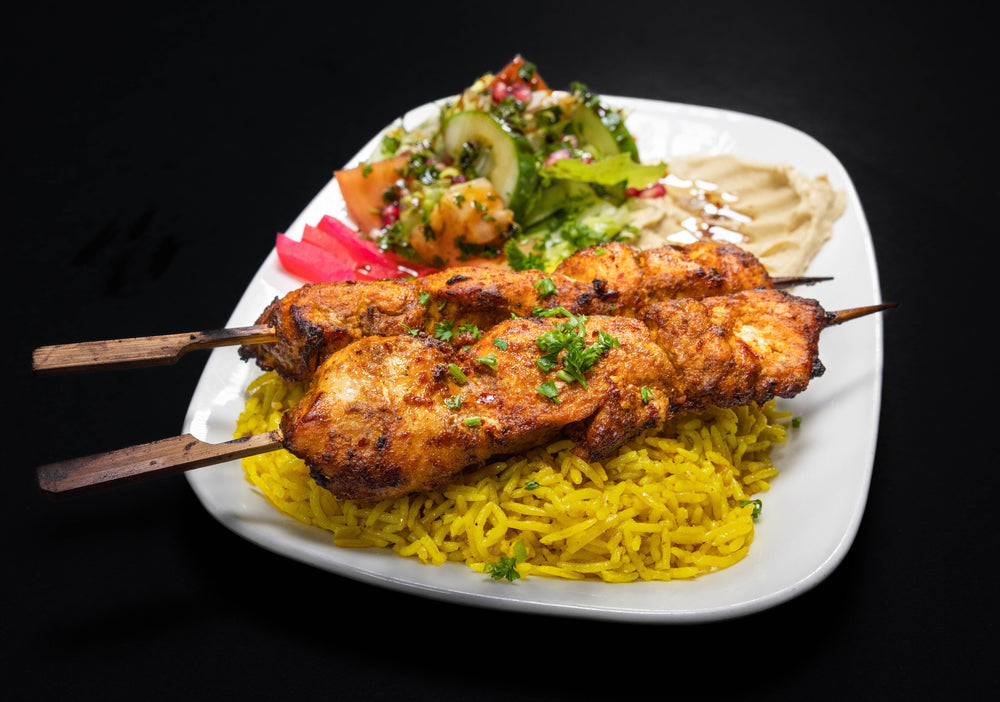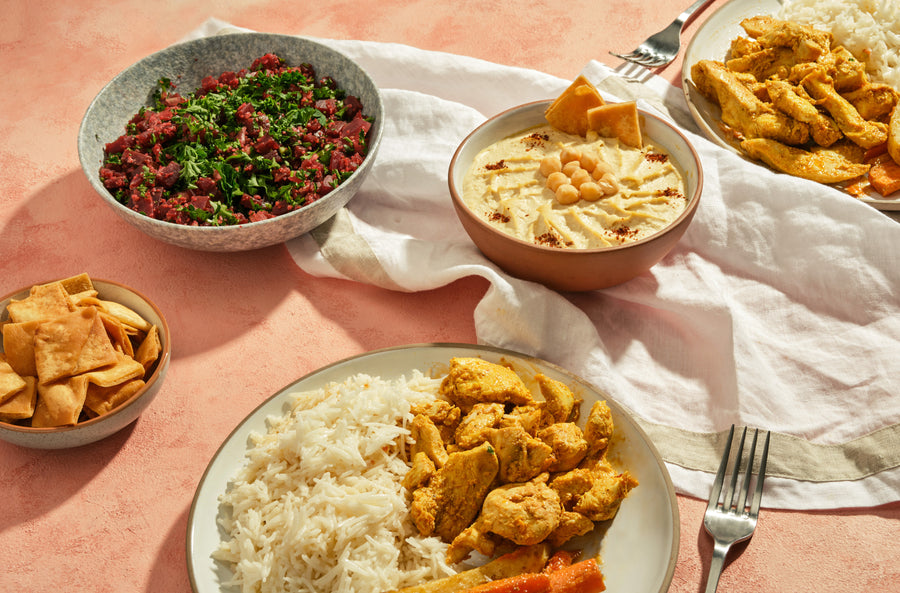A Deep Study Syrian Food: Comprehending Its Cultural Relevance and Halal Elements
Syrian cuisine personifies a rich tapestry of cultural influences and historical stories. Each meal narrates of community and practice, emphasizing the importance of shared dishes. The adherence to halal methods not only mirrors faiths but likewise shapes the identity of Syrian food preparation. As worldwide occasions challenge these cooking traditions, the durability of this cuisine stays a centerpiece of social preservation. What lies behind the flavors that define this enduring heritage?
The Historic Roots of Syrian Cuisine
Although Syrian cuisine has progressed over centuries, its historical roots are deeply intertwined with the region's diverse social influences. Situated at the crossroads of various worlds, Syria has actually taken in culinary techniques from the Phoenicians, Greeks, Romans, and Ottomans, among others. This abundant tapestry of background has actually contributed to a food defined by a mix of flavors, seasonings, and cooking methods. The abundant lands of the area have also played an essential duty, providing an abundance of grains, fruits, and vegetables that create the foundation of lots of meals. The intro of brand-new active ingredients through trade and conquest additionally improved the cooking landscape, enabling the growth of distinct local specializeds. Additionally, the influence of bordering countries has led to a vibrant exchange of culinary ideas, solidifying Syria's setting as a significant player in the more comprehensive context of Middle Eastern gastronomy.

Traditional Syrian Meals and Their Cultural Value
Traditional Syrian meals are not only cooking staples but likewise bring deep social significance, showing the nation's rich heritage. Legendary dishes, commonly prepared during festive events, serve as a way of uniting neighborhoods and family members. These dishes symbolize the flavors of Syria while enhancing social bonds through shared practices and parties.
Iconic Syrian Staples
When discovering the rich tapestry of Syrian cuisine, one uncovers a variety of famous dishes that not only tantalize the taste buds yet likewise personify the nation's cultural heritage. Amongst these staples, Kabsa stands apart as a great smelling rice recipe, commonly seasoned with spices like saffron and cardamom, representing friendliness. Fattoush, a vibrant salad made with combined eco-friendlies and crunchy bread, reflects the relevance of fresh components in Syrian food preparation. Muhammara, a spicy dip made from peppers and walnuts, showcases the rich flavors characteristic of the region. Furthermore, Kibbeh, a meal made from bulgur and minced meat, is typically considered as a nationwide prize, standing for communal gatherings. Each meal informs a tale, attaching individuals to their practices and origins.
Festive Meal Customs
Syrian joyful meal customs are abundant with significance and significance, as family members collect to commemorate crucial celebrations through the sharing of beloved meals. Meals typically showcase a range of conventional foods, with meals like kibbeh, tabbouleh, and mansaf taking center stage. Each dish lugs cultural background; for example, kibbeh, made from bulgur and minced meat, stands for hospitality and wealth. Throughout Ramadan and Eid, households prepare special sweets such as maamoul, signifying pleasure and unity. These celebrations promote area bonds, as sharing a dish represents love and togetherness. The preparation and pleasure of these recipes mirror Syria's diverse culinary heritage, linking family custom-mades and local influences, therefore enriching the cheery experience and protecting cultural identification.
The Function of Family and Area in Syrian Food Culture
Food serves as an important string that weaves together family and area in Syrian society. Meals are typically public experiences, where family members gather around a table to share conventional recipes that reflect their heritage. The prep work of food is a communal task, with generations working side by side, giving recipes and food preparation techniques. This technique reinforces domestic bonds and promotes a feeling of belonging within the community.Special events and spiritual celebrations better highlight the value of food in Syrian society. During these occasions, family members prepare intricate dishes that serve not just to nourish but also to reveal love and hospitality. The act of sharing food represents unity and support amongst pals and next-door neighbors, enhancing social connections. Via these shared culinary experiences, Syrians grow a solid identity rooted in their rich cultural background, highlighting just how food transcends simple nutrition to become a critical part of their social fabric.
Halal Practices in Syrian Cooking
In the context of public dishes and family members events, halal techniques play a significant role in Syrian cooking. These methods originate from Islamic nutritional regulations, ensuring that food is ready and eaten in a way that lines up with faiths. For many Syrian households, adherence to halal principles influences various aspects of meal preparation, from sourcing components to cooking methods.Animals made use of for meat must be butchered according to details guidelines, emphasizing gentle treatment and conjuring up the name of Allah. In addition, cross-contamination with non-halal things is meticulously avoided in both home kitchens and commercial establishments.This dedication to halal not just mirrors spiritual dedication but also cultivates a feeling of neighborhood, as family members usually integrated to share meals that honor these traditions - Brunch Kitsilano Vancouver BC. Consequently, halal practices are deeply woven right into the textile of Syrian cooking society, shaping both everyday life and festive celebrations
Ingredients That Specify Syrian Flavors

The significance of Syrian food is shaped by a harmonious mix of essential flavors and herbs that improve its unique flavors. Conventional cooking techniques even more elevate these ingredients, showcasing the rich cooking heritage of the area. An overview of important ingredients reveals the foundational role they play in developing authentic Syrian dishes.
Key Seasonings and Herbs
A vibrant tapestry of tastes defines Syrian cuisine, with key spices and natural herbs playing a vital duty in defining its significance. Famous among these are coriander, sumac, and cumin, which lend deepness and warmth to various meals. Cumin, with its nutty scent, often enhances stews and smoked meats, while coriander includes a citrusy note to dips and salads. Sumac, understood for its appetizing taste, brightens dishes and is regularly sprinkled over fattoush or kebabs. Furthermore, cinnamon and allspice provide a refined sweet taste, frequently located in both sweet and mouthwatering prep work. Fresh herbs like dill, parsley, and mint are additionally essential, providing a ruptured of freshness and stabilizing the rich, complicated flavors that make Syrian cuisine unique.
Standard Food Preparation Techniques
Cooking methods in Syrian cuisine reflect an ingrained custom that improves the tastes of its active ingredients. Techniques such as slow-cooking and braising are frequently employed, enabling seasonings and herbs to combine beautifully with meats and vegetables. Barbecuing, especially over charcoal, presents a smoky richness to dishes like kebabs, while steaming is typically utilized for rice, preserving its appearance and preference. Furthermore, sautéing is favored for preparing aromatic bases, usually beginning important link with onions and garlic to build depth. Fermentation contributes in producing special flavors, apparent in recipes like pickled vegetables. These techniques home not only highlight the quality of ingredients yet likewise symbolize the public spirit of cooking, bringing families with each other around shared dishes soaked in tradition.
Essential Components Review
While exploring Syrian food, one swiftly uncovers that crucial ingredients play a crucial function in defining its one-of-a-kind tastes. Olive oil, a staple, gives splendor and deepness, frequently acting as a base for several recipes. Fresh natural herbs, such as mint, cilantro, and parsley, contribute vivid scents and preferences, enhancing the total experience (Brunch Kitsilano Vancouver BC). Seasonings like cumin, coriander, and cinnamon are frequently utilized, adding warmth and complexity to meals. Additionally, Syrian cuisine heavily integrates grains, especially bulgur and rice, which function as essential parts in numerous dishes. Pulses, specifically lentils and chickpeas, supply both nourishment and texture. With each other, these ingredients develop the unified equilibrium that defines Syrian meals, showing the nation's abundant cooking heritage and cultural significance
The Impact of War on Syrian Cooking Customs
Although the war in Syria has actually functioned destruction throughout the nation, its effect on cooking customs discloses a complex interaction of resilience and adaptation. As areas encountered displacement, typical dishes were customized because of the deficiency of components and sources. Households commonly count on in your area offered produce, integrating brand-new flavors and strategies right into their meals, which led to the appearance of distinct analyses of timeless dishes.Moreover, the battle fostered a spirit of uniformity amongst displaced chefs and home cooks, who shared their culinary knowledge with social media sites and area cooking areas. This sharing of dishes not just preserved cultural heritage however additionally developed a sense of belonging among those influenced by the conflict. Regardless of the challenges, the interest for food continues to be a unifying force, allowing individuals to maintain their identity and get in touch with their roots, even in exile. Syrian cuisine proceeds to develop in the middle of adversity, reflecting both an abundant history and contemporary strength.
Often Asked Questions
What Are Common Food Preparation Strategies Utilized in Syrian Cuisine?
Typical food preparation techniques in Syrian food include cooking, cooking, sautéing, and stewing. These techniques boost tastes and structures, permitting the development of varied recipes that show the area's abundant cooking heritage and traditions.
Just How Has Globalization Influenced Syrian Food?

Exist Vegetarian Options in Standard Syrian Recipes?
Vegan alternatives prevail in conventional Syrian recipes, including active ingredients like vegetables, lentils, and chickpeas. Popular recipes such as Mujadara and Falafel emphasize this variety, fitting numerous nutritional preferences while maintaining the rich flavors of the cuisine.
What Beverages Pair Well With Syrian Meals?
Beverages that combine well with Syrian meals consist of mint tea, pomegranate juice, and ayran - Brunch Kitsilano Vancouver BC. These beverages complement the flavors of standard dishes, enhancing the dining experience while providing stimulating contrasts to the abundant, full-flavored tastes
How Do Syrians Commemorate Food During Holidays or Festivals?
Syrians commemorate food during holidays and celebrations with elaborate banquets, commonly featuring conventional recipes. Family members gatherings highlight sharing dishes, representing unity and cultural heritage, while special deals with and desserts highlight the joyful spirit and communal happiness. Standard Syrian recipes are not only culinary staples but likewise bring deep social value, reflecting the country's rich heritage. When discovering the rich tapestry of Syrian food, one discovers a selection of legendary dishes that not only tantalize the taste buds yet also embody the country's cultural heritage. Syrian cheery dish practices are abundant with significance and relevance, as family members collect to commemorate crucial events through the sharing get more of precious recipes. Cooking methods in Syrian cuisine mirror an ingrained practice that boosts the tastes of its components. Vegetarian choices are prevalent in traditional Syrian meals, featuring ingredients like lentils, vegetables, and chickpeas.